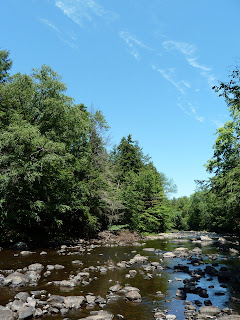Dad, the kids and I went up for the weekend to see how things were going with the cabin build project. As we pulled up, I'll admit being a bit disappointed that I couldn't see any changes. Only on walking into the cabin did I notice that the porch had been built. Wow, what a nice surprise! The 10ft depth and 40ft length made it a bold feature of the cabin overall. It looked great from where I was standing on the porch itself and from creekside, it gave the formerly boxy structure a real cabin look. The rafters are log, just as inside, and the header made of 6x6" beam, giving it a hybrid appearance which could be best described as Amish post and beam meets log cabin.
 |
| Lots of space to enjoy! |
 |
| Logs and posts... a good combo |
 |
| First of many future mornings spent on the porch. |
 |
| 80 ft down, viewed from the creek |
 |
| With the porch added, there's a more "cabiny" feel |
It was mid morning and already hot. The humidity was bearable but in what may be a sign of things to come, the kids and I ran down from the cabin, and started wading around in the creek. The time passes quickly when you mix kids, a hot day, and a cool creek filled with minnows, crayfish, and other delights. After an hour, we set out for lunch.
 |
| Looking for crayfish |
Back at the guest cabin, dad made slow but steady progress on the shower door we had picked up at Utica. He was frustrated by his lack of progress, but admittedly, we were busy with other things and enjoying ourselves. No deadlines here. We all swam in the creek, even dad, who said it cooled him off for the rest of the evening. I built the dining room table, while my daughter built a chair. My son stoked the fire.


Cool nights meant everyone needed a blanket. Great sleeping weather, indeed. Sunday brought forth another scorcher, which, by mid morning saw me and the kids seeking respite in the creek. What had been a dangerous, raging body of water weeks earlier had been tamed by 10 days without rain. Scarcely a foot deep in most places, the creek was some 3 feet in one particular area we had determined would be our swimming hole. The kids and I spent a good 2 hours splashing around, building a dam of rocks, chasing crayfish, and taking photos of minnows. If the day had been hot, we didn't feel it. So good to have the creek running through the camp.
 |
| The day was around 90, the water, around 82. |
The drive up took well over 5 hours thanks to traffic, but hearing my son say, "this was the best trip ever, dad!", made it well worth the effort. "Thanks for buying this land for us to enjoy". Now that's music to my ears.







































